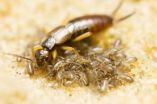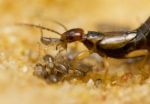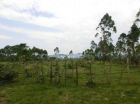(Press-News.org) Looking at the question of how social behavior has developed over the course of evolution, scientists from the universities in Mainz and Basel have gained new insights from the study of earwigs. "Young earwig offspring don't simply compete for food. Rather the siblings share what is available amongst themselves, especially when the mother is absent," explained Dr. Joël Meunier of the Evolutionary Biology section of the Institute of Zoology at Johannes Gutenberg University of Mainz (JGU). The team of biologists from Mainz University and the University of Basel investigated the interactions between siblings of the European earwig (Forficula auricularia). To date, insects have been only little studied with regard to cooperative behavior between siblings, except in the case of eusocial species, such as bees and ants. The European earwig provides, as the research project shows, valuable clues to the origins of social behavior patterns.
The animal kingdom has an unbelievable diversity of forms of social life. These encompass situations such as the temporary aggregation of single individuals to social communities based on the division of labor. For evolutionary biologists this poses question of how these ubiquitous social life forms emerged despite the accompanying disadvantages of competition and conflict among group members. When it comes to birds, for example, the competition among siblings is often so fierce that some of the younger animals die.
"In the case of earwigs, we have a system that closely resembles the primitive conditions of family life," said Jos Kramer, a doctoral candidate on Meunier's team. In fall, female earwigs lay on average 40 to 45 eggs and stay over the winter with them. The mothers watch the eggs, keep them clean by licking off fungi, for example, and carry them back and forth in the nest. Once the young, the so-called nymphs, emerge, they stay in the nest for few weeks with their mothers, even if the presence of this latter is no longer necessary for their survival. Indeed, the nymphs could leave the family unit soon after emergence and take care of themselves from then on.
These sub-social forms of life provide the ideal field of research for investigating under what conditions the advantages of cooperation in a family unit outweigh the disadvantages. For this purpose, the scientists from Mainz and Basel provided 125 earwig families with dyed pollen and observed if and how the food was divided amongst the siblings. "We found that siblings behave cooperatively and share food and that this behavior occurs much more frequently when the mother is not present and is not feeding her offspring herself," stated Meunier. This may at least partly explain why mobile offspring stay with the family group despite the disadvantages associated with this. In addition, this insight provides an important clue to the early development of social behavior. The previously largely ignored aspect of sibling cooperation is possibly one of the key factors that promoted the transition from solitary to social life.
INFORMATION:
Publication:
Joachim Falk et al.
Sibling Cooperation in Earwig Families Provides Insights into the Early Evolution of Social Life
The American Naturalist, 11 February 2014
DOI: 10.1086/675364
Sibling cooperation in earwig families gives clues to early evolution of social behavior
Biologists from Mainz and Basel investigate food sharing among siblings in 125 earwig families
2014-04-15
ELSE PRESS RELEASES FROM THIS DATE:
Charitable donation discrepancies: Why are some countries more generous than others?
2014-04-15
When it comes to charitable giving, some countries open their collective wallets more than others. According to a new study in the Journal of Consumer Research, people who live in countries that promote equality in power and wealth are more likely to donate money than those who live in societies that expect and accept inequality.
"Our research examines whether cultural values can explain the different levels of charitable giving between different countries," write authors Karen Page Winterich (Pennsylvania State University) and Yinlong Zhang (University of Texas, San ...
Chew on this: How does food texture impact its perceived calorie content?
2014-04-15
Food is an intimately personal thing; we savor some tastes and despise others. But how does the way we chew and eat our food impact our overall consumption? According to a new study in the Journal of Consumer Research, people perceive foods that are either hard or have a rough texture to have fewer calories.
"We studied the link between how a food feels in your mouth and the amount we eat, the types of food we choose, and how many calories we think we are consuming," write authors Dipayan Biswas, Courtney Szocs (both University of South Florida), Aradhna Krishna (University ...
Consumer predictions: Do categories matter when predicting the lottery or stock market?
2014-04-15
From sports to the stock market and even winning the lottery, it's in our nature to predict who or what will come out on top. But, sometimes we can't see the forest for the trees. According to a new study in the Journal of Consumer Research, people are more likely to make a prediction about something when it is grouped in a large category of similar items.
"One factor that can contribute to a person's flawed judgment is categorization," write authors Mathew S. Isaac (Seattle University) and Aaron R. Brough (Utah State University). "When making a prediction, we can become ...
Can refined categorization improve prediction of patient survival in RECIST 1.1
2014-04-15
In a recent analysis by the RECIST Working Group published in the European Journal of Cancer, EORTC researchers had explored whether a more refined categorization of tumor response or various aspects of progression could improve prediction of overall survival in the RECIST database. They found that modeling target lesion tumor growth did not improve the prediction of overall survival above and beyond that of the other components of progression. The RECIST Working Group includes the EORTC, the United States National Cancer Institute, and the National Cancer Institute of ...
New method isolates immune cells for researchers to study how they ward off oral diseases
2014-04-15
Case Western Reserve University dental researchers have found a less invasive way to extract single rare immune cells from the mouth to study how the mouth's natural defenses ward off infection and inflammation.
By isolating some specialized immune cells (white blood cells known as "leukocytes") to study how they fight diseases in the mouth—or reject foreign tissues, such as in failed organ transplants—researchers hope to learn more about treating and preventing such health issues as oral cancers, cardiovascular disease, AIDS and other infectious diseases.
To this point, ...
Study: Deforestation could intensify climate change in Congo Basin by half
2014-04-15
By 2050, deforestation could cause temperatures in the Congo Basin to increase by 0.7 °C. The increase would intensify warming caused by greenhouse gases by half, according to a study by researchers at the University of Leuven, Belgium.
Explosive population growth and inefficient agricultural practices are causing large-scale destruction of tropical rainforests in Central Africa. A team of researchers from the University of Leuven examined how these practices will affect longer-term temperatures in the region. Using a sophisticated computer model, they forecasted Congo ...
Saturn's rings reveal how to make a moon
2014-04-15
Disturbances in the icy rings of Saturn have given scientists an insight into how moons are made.
Writing in the journal Icarus this week, Professor Carl Murray from Queen Mary's Astronomy Unit reports that recently discovered disturbances at the very edge of Saturn's outer bright A ring result from a small icy object that formed within the ring and which may be in the process of migrating out of it. They have nicknamed the object, 'Peggy'.
"We hadn't seen anything like this before," explained Professor Murray. "We may be looking at the act of birth, where this object ...
A screening process for early identification of infants at risk of autism
2014-04-15
The aim of this study was to develop a screening tool to identify infants prior to 12 months at risk for autism spectrum disorder (ASD) and developmental learning delay (DLD) and provide immediate determination of risk for autism spectrum disorder. The importance of early detection and treatment for children with ASD has been well documented. Since 2006, the American Academy of Pediatrics has recommended routine screening measures for toddlers at risk for ASD at 18 and 24 months of age, however the authors of this study were not aware of any screening questionnaires available ...
Researchers help Boston Marathon organizers plan for 2014 race
2014-04-15
After experiencing a tragic and truncated end to the 2013 Boston Marathon, race organizers were faced not only with grief but with hundreds of administrative decisions, including plans for the 2014 race – an event beloved by Bostonians and people around the world.
One of the issues they faced was what to do about the nearly 6,000 runners who were unable to complete the 2013 race. The Boston Athletic Association, the event's organizers, quickly pledged to provide official finish times for these runners. Thinking ahead, they also had to consider how to provide these runners ...
Bizarre parasite may provide cuttlefish clues
2014-04-15
University of Adelaide research into parasites of cuttlefish, squid and octopus has uncovered details of the parasites' astonishing life cycles, and shown how they may help in investigating populations of their hosts.
Researcher Dr Sarah Catalano has described 10 new parasite species− dicyemid mesozoans −, which live in the kidneys of cephalopods (cuttlefish, squid and octopus). They are the very first dicyemid species to be described from Australian waters.
"Although dicyemid parasites have been studied by other groups, nothing has been known about dicyemid ...
LAST 30 PRESS RELEASES:
SIMJ announces global collaborative book project in commemoration of its 75th anniversary
Air pollution exposure and birth weight
Obstructive sleep apnea risk and mental health conditions among older adults
How talking slows eye movements behind the wheel
The Ceramic Society of Japan’s Oxoate Ceramics Research Association launches new international book project
Heart-brain connection: international study reveals the role of the vagus nerve in keeping the heart young
Researchers identify Rb1 as a predictive biomarker for a new therapeutic strategy in some breast cancers
Survey reveals ethical gaps slowing AI adoption in pediatric surgery
Stimulant ADHD medications work differently than thought
AI overestimates how smart people are, according to HSE economists
HSE researchers create genome-wide map of quadruplexes
Scientists boost cell "powerhouses" to burn more calories
Automatic label checking: The missing step in making reliable medical AI
Low daily alcohol intake linked to 50% heightened mouth cancer risk in India
American Meteorological Society announces Rick Spinrad as 2026 President-Elect
Biomass-based carbon capture spotlighted in newly released global climate webinar recording
Illuminating invisible nano pollutants: advanced bioimaging tracks the full journey of emerging nanoscale contaminants in living systems
How does age affect recovery from spinal cord injury?
Novel AI tool offers prognosis for patients with head and neck cancer
Fathers’ microplastic exposure tied to their children’s metabolic problems
Research validates laboratory model for studying high-grade serous ovarian cancer
SIR 2026 delivers transformative breakthroughs in minimally invasive medicine to improve patient care
Stem Cell Reports most downloaded papers of 2025 highlight the breadth and impact of stem cell research
Oxford-led study estimates NHS spends around 3% of its primary and secondary care budget on the health impacts of heat and cold in England
A researcher’s long quest leads to a smart composite breakthrough
Urban wild bees act as “microbial sensors” of city health.
New study finds where you live affects recovery after a hip fracture
Forecasting the impact of fully automated vehicle adoption on US road traffic injuries
Alcohol-related hospitalizations from 2016 to 2022
Semaglutide and hospitalizations in patients with obesity and established cardiovascular disease
[Press-News.org] Sibling cooperation in earwig families gives clues to early evolution of social behaviorBiologists from Mainz and Basel investigate food sharing among siblings in 125 earwig families



